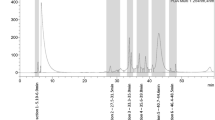Abstract—
The present study investigated Punica granatum extract (PGE) as potential proliferation inhibitory agent for bladder cancer cells and elucidated the possible mechanism. PGE reduced viabilities of HT-1197 and RT4 cells in concentration-based manner at 72 h. Colony forming potential of HT-1197 and RT4 cells was also significantly (p < 0.05) inhibited on exposure to 2 and 12 mg/mL PGE. Exposure to 12 mg/mL PGE for 72 h significantly (p < 0.05) decreased miR‑10b expression and suppressed migration potential of HT-1197 and RT4 cells. In PGE exposed HT-1197 and RT4 cells, invasiveness was reduced to 30.25 and 33.47%, respectively. PGE treatment of HT-1197 and RT4 cells caused a significant (p < 0.05) elevation in HOXD10 protein and mRNA levels compared to control. The miR‑10b mimic transfection in HT-1197 and RT4 cells reversed inhibitory effect of PGE on cell viability. Thus, PGE exhibited cytotoxicity and anti-invasive effect on HT-1197 and RT4 cells through targeting miR‑10b and up-regulation of HOXD10 expression. Thus, PGE may be developed as therapeutic agent for treatment of bladder cancer.






Similar content being viewed by others
REFERENCES
Zhang, Y., Xu, F., Zhang, F.Q., Song, L., and Chen, C., Recent perspectives of bladder cancer diagnostics, Minerva Med., 2016, vol. 107, pp. 162–166.
Antoni, S., Ferlay, J., Soerjomataram, I., Znaor, A., Jemal, A., and Bray, F., Bladder cancer incidence and mortality: A global overview and recent trends, Eur. Urol., 2017, vol. 71, pp. 96–108.
Siegel, R.L., Miller, K.D., and Jemal, A., Cancer statistics, 2017, CA Cancer J. Clin., 2017, vol. 67, pp. 7–30.
Zuiverloon, T.C. and Theodorescu, D., Pharmacogenomic considerations in the treatment of muscle-invasive bladder cancer, Pharmacogenomics, 2017, vol. 18, pp. 1167–1178.
Lewis, B.P., Burge, C.B., and Bartel, D.P., Conserved seed pairing, often flanked by adenosines, indicates that thousands of human genes are microRNA targets, Cell, 2005, vol. 120, pp. 15–20.
Falzone, L., Romano, G.L., Salemi, R., Bucolo, C., Tomasello, B., Lupo, G., Anfuso, C.D., Spandidos, D.A., Libra, M., and Candido, S., Prognostic significance of deregulated microRNAs in uveal melanomas, Mol. Med. Rep., 2019, vol. 19, pp. 2599–2610.
Falzone, L., Candido, S., Salemi, R., Basile, M.S., Scalisi, A., McCubrey, J.A., Torino, F., Signorelli, S.S., Montella, M., and Libra, M., Computational identification of microRNAs associated to both epithelial to mesenchymal transition and NGAL/MMP-9 pathways in bladder cancer, Oncotarget, 2016, vol. 7, pp. 72758–72766.
Bellmunt, J., Yeh, S., Rosenberg, J.E., and Berman, D.M., The evolving understanding of microRNA in bladder cancer, Urol. Oncol., 2014, vol. 32, p. 41. e31‑40.
Xu, T., Qin, L., Zhu, Z., Wang, X., Liu, Y., Fan, Y., Zhong, S., Wang, X., Zhang, X., Xia, L., et al., MicroRNA-31 functions as a tumor suppressor and increases sensitivity to mitomycin-C in urothelial bladder cancer by targeting integrin α5, Oncotarget, 2016, vol. 7, pp. 27445–27457.
Lansky, E.P., Jiang, W., Mo, H., Bravo, L., Froom, P., Yu, W., et al., Possible synergistic prostate cancer suppression by anatomically discrete pomegranate fractions, Invest. New Drugs, 2005, vol. 23, pp. 11–20.
Yu, B., Gao, W., Zhou, H., Miao, X., Chang, Y., Wang, L., Xu, M., and Ni, G., Propofol induces apoptosis of breast cancer cells by downregulation of miR‑24 signal pathway, Cancer Biomark., 2018, vol. 21, pp. 513–519.
Bahena‑Ocampo, I., Espinosa, M., Ceballos‑Canci-no, G., Lizarraga, F., Campos‑Arroyo, D., Schwarz, A., Maldonado, V., Melendez‑Zajgla, J., and Garcia‑Lopez, P., miR‑10b expression in breast cancer stem cells supports self‑renewal through negative PTEN regulation and sustained AKT activation, EMBO Rep., 2016, vol. 17, pp. 648–658.
Xiao, H., Li, H., Yu, G., Xiao, W., Hu, J., Tang, K., Zeng, J., He, W., Zeng, G., Ye, Z., and Xu, H., MicroRNA‑10b promotes migration and invasion through KLF4 and HOXD10 in human bladder cancer, Oncol. Rep., 2014, vol. 31, pp. 1832–1838.
Nakayama, I., Shibazaki, M., Yashima‑Abo, A., Miura, F., Sugiyama, T., Masuda, T., and Maesawa, C., Loss of HOXD10 expression induced by upregulation of miR‑10b accelerates the migration and invasion activities of ovarian cancer cells, Int. J. Oncol., 2013, vol. 43, pp. 63–71.
Author information
Authors and Affiliations
Corresponding authors
Ethics declarations
The authors declare no conflict of interest in the publication of these results.
COMPLIANCE WITH ETHICAL STANDARDS
This article does not contain any studies involving animals or human participants performed by any of the authors.
AUTHOR CONTRIBUTIONS
Rui Sun and Junjun Zhang both are the first authors, they contributed equally.
Rights and permissions
About this article
Cite this article
Sun, R., Zhang, J., Chen, L. et al. Punica granatum Extract Inhibits Bladder Cancer Cell Viability, Invasion and Migration through Down-Regulation of HOXD10 Signalling Pathway. Dokl Biochem Biophys 497, 130–136 (2021). https://doi.org/10.1134/S1607672921020162
Received:
Revised:
Accepted:
Published:
Issue Date:
DOI: https://doi.org/10.1134/S1607672921020162




